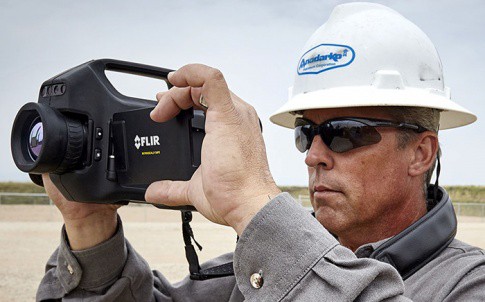
FLIR Systems received a Technology Innovation Award for its Optical Gas Imaging (OGI) cameras, the GF320 and GFx320 at the recent Oil and Gas Methane Leadership Awards surrounding the Global Methane Forum** in Toronto, Canada.
The award, given by the Center for Clean Air Policy, Clean Air Task Force, Environmental Defence Canada, Environmental Defense Fund, and the Pembina Institute, recognizes FLIR for its leadership and innovation in the creation of gas detecting cameras that are used in the Oil and Gas industry to identify and stop fugitive gas emissions.
The FLIR GF320 and GFx320 allow oil and gas field personnel to visualize and geotag fugitive methane emissions in a manner that is compliant with the US EPA’s OOOOa methane rule. Using these cameras, FLIR has enabled oil and gas industry clients around the world to survey oil and gas facilities up to nine times faster than with traditional methods. In doing so, FLIR's technology has helped these companies reduce their impact on the environment and made a positive impact on their bottom line.
The states of California and Colorado also received awards for Leadership by a Subnational Government. Mexico was recognized as an Emerging Leader for its commitment to reducing methane emissions by 40-45% and the consequent work in developing a sector-wide regulation covering methane emissions across the supply chain.
FLIR Systems are honored to receive this award and are committed to advancing innovation to save lives and livelihoods. For further information on the GF320 or GFx320 please visit www.flir.com or contact FLIR Systems at gasimaging@flir.com / +32-3665-5100.
FLIR Systems, Inc. is a world leader in the design, manufacture, and marketing of sensor systems that enhance perception and awareness. FLIR’s advanced thermal imaging and threat detection systems are used for a wide variety of imaging, thermography, and security applications, including airborne and ground-based surveillance, condition monitoring, research and development, manufacturing process control, search and rescue, drug interdiction, navigation, transportation safety, border and maritime patrol, environmental monitoring, and chemical, biological, radiological, nuclear, and explosives (CBRNE) detection. For more information, go to FLIR’s web site at www.FLIR.com.










Radio wave weapon knocks out drone swarms
I hope they have assessed how easy it is to shield a drone against the attack. Hopefully the shielding would add too much weight.